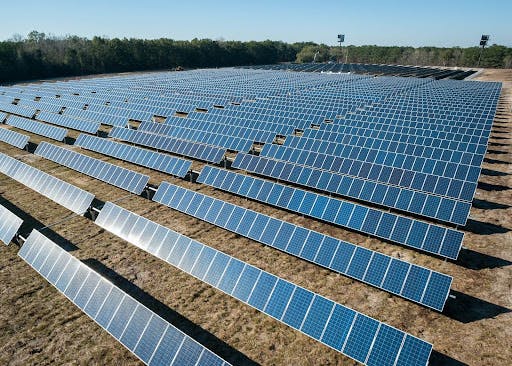Everything You Need To Consider When Starting A Solar Farm
6 Mar 2023

The popularity of solar farm development has increased over the last decade as the need for alternative sources of energy increases. 2023 is no different, with global solar generation expected to surpass a terawatt.
Further to this, landowners are turning to the development of solar farms (which is a fantastic farm diversification idea) as a way to generate additional streams of income, buoyed by an ever-increasing renewable energy investment market and favourable development conditions led by various government incentive plans.
This article will explore what needs to be considered when starting a solar farm, taking a look at what constitutes a solar farm, the different types, considerations when developing your solar farm and finally, how to seek out financial investment to bring your project to life.
Table of Contents:
- What is a solar farm?
- How do you make money from a solar farm?
- Solar farm development considerations
- How PF Nexus can help
- Conclusion
What is a solar farm?
Solar farms - also known as photovoltaic (PV) power stations or solar power plants - are made up of a series of ground-mounted solar panels that absorb sunlight with photovoltaic cells, which is then converted to usable alternating current (AC) using inverter technology.
The size of these farms is dependent on what it is used for but generally, solar farms can range from an acre to hundreds of acres. There are two main kinds of solar farms: utility-scale solar farms and community solar farms.
A utility-scale solar farm is a particularly large farm. There is no fixed definition because this depends upon the market in the solar farm is being built in. In some places, farms producing only 1 MW of power are counted as utility-scale, while in others, utility-scale solar farms must produce more than 25 MW.
These farms will often have long-term agreements in place - often 10-20 years - with an ‘offtaker’ such as a utility company, government entity, or private business to buy their energy in what is known as a Private Purchase Agreement (PPA). We’ll discuss this in greater detail later on in this article.
Community-scale solar farms are generally smaller and provide power used for commercial or community consumption in a local area. Often working on a subscription basis, residents or local inhabitants can subscribe to a local community solar farm, using it to typically enjoy reduced power bills as a result.
In the UK, solar energy currently accounts for 6.8% of the renewable energy share of electricity generated. In the EU, the total solar power capacity grew by 25% in 2022 alone. Experts predict that the market will more than double in the next 4 years. At present, the global solar power market is worth approximately USD 234 billion.
The really encouraging aspect of solar farm development is how accessible it is to private individuals when compared to fossil fuel energy production. Granted, establishing a solar farm is a cost intensive investment, however, routes to third party investment are becoming more accessible as we’ll explore later on in this article. Further to this, the cost of generating solar energy becomes cheaper with every passing year due to advances in technology and the widespread production of solar generation components.
How do you make money from a solar farm?
Traditionally, there are two main ways to make money from solar farms. These include leasing land to a renewable developer or, developing the land and operating the solar farm yourself.
In the UK, there is currently a boom in farmers leasing out their land to renewable energy project developers due to the increasing unpredictability of seasonal farming. In return, they are being paid at a rate that is more profitable to the crops that would have been grown on that land, around £850-£1,100 per acre, per annum.
The chief benefit to leasing your land is that you just need to provide the land, and the project developer will do the rest.
On the other hand, if landowners have access to renewable energy project investment to develop the solar farm themselves, they stand to make money off the electricity that they generate. It’s estimated that this ranges from an ROI of 10%-20% per annum. These numbers vary, in the US for instance, it’s possible to make $21,250- $42,500 per acre per annum.
It’s important to consider where your solar farm is situated as this will determine how much solar energy it will be able to generate.
Whichever model you choose, income will be generated by selling energy to off-takers that include utilities, government entities, or private businesses via a Private Purchase Agreement (PPA). PPAs provide off-takers with a reliable source of clean energy over a specified period at a fixed rate or a variable rate (not too dissimilar to how house mortgages work).

Solar farm development considerations
If you choose to act as the project developer and build the solar farm, there are a number of considerations that you need to be aware of before committing. Below, we’ve compiled a list of these considerations.
Site selection
Location can make a big difference, not just in terms of solar irradiance but also, in whether or not your solar project can go ahead.
The first consideration is the amount of sunlight/direct light the area gets as this will massively impact the output of the panels. The land should be flat, and ideally south-facing. It should get at least 4 hours of peak sun per day.
You will need to check the local zoning laws and land-use regulations. In the UK, for example, you will need planning permission to ground-mount more than 9 square metres of solar panels. Unused land and brownfields are more likely to be granted permission for development.
Of course, access to the grid is a key factor too. You’ll need to make sure that your land will have access to the grid. Finally, an area with minimal flood risk is preferable to ensure that your infrastructure is not damaged.
Financial planning
Starting a solar farm is capital intensive, more so at the beginning of the project during the infrastructure build. It’s important to note that costs continue to decrease in this regard with the cost of setting up a solar farm today 80% less than it would have cost back in 2010.
In the UK, the cost of solar panel modules works out to roughly £200,000 for every megawatt of power produced, before inverters, land cost and other key infrastructure like grid connections are accounted for. To put it in perspective, to generate 1 MW of power will require 5 acres of land. The average cost of an acre of farmland costs in the region of £7,500-£10,000. The total result is often over £600,000 per megawatt in the current market.
Building a solar farm therefore typically costs upward of a million pounds, so it’s important to make sure that you have thought about how you are going to finance your solar project.
There are many funding options open, including financing part of the capital expenditure through raising debt, and typically bringing on board investors to cover much of the remainder. You may give equity in exchange for the money, or agree on repayment options with a financial institution and retain full ownership of the solar farm.
You can learn more about funding and how to source capital for a solar farm in our guide on ‘Solar Power Project Financing: Funding Your Solar Project’.
Depending on where you are in the world, various governments have implemented incentives to promote the development of solar energy infrastructure. What you can access will depend on where you are and the current schemes, but common financial incentives include tax incentives, capital subsidies, subsidised loans, and generation-based incentives.
How much financing you need and what financing options are right for you will depend heavily on how big your solar farm will be, where it’s going to be built, who it will serve, and more. Think about whether you are creating a utility-scale farm, a solar farm for a specific nearby commercial offtaker, or a farm just to power nearby residential consumption. The size and type of offtaker will determine the revenue risk and hence the kind of financing options available.
If you are seriously considering starting a utility-scale solar farm and are looking for financing options or investors, the PF Nexus renewable energy project marketplace is a great place to connect with the right parties.
Our platform allows you to research investors yourself, or utilise our marketplace to match with lenders & investors looking for projects to get involved with. The platform gives you direct access to a myriad of financing options. With an ecosystem of over 4,000 clean energy stakeholders, you’re bound to find someone to join you on your solar farm journey.
Equipment and technology
It’s important to understand the equipment that you are purchasing and the pros and cons that come with each part. We suggest both additional research and speaking to an advisor before going ahead with anything, but here are a few basics that you may find useful.
You’re going to need the right solar panels and inverters to suit your farm’s scale. You will need to decide whether you are going to install monocrystalline or polycrystalline panels. Each has its own pros and cons.
Monocrystalline panels are more expensive, but they are more efficient and generally last longer than polycrystalline ones. On the other hand, polycrystalline panels are cheaper but less effective. If you are in a less irradiated region, monocrystalline panels may be best compared to a solar farm in a highly irradiated region like Italy, which may go for polycrystalline panels.
You will also need to think about battery systems and evaluate the different options. Battery systems are currently very expensive, but they are an important part of the setup so doing your research is important.
You may want to consider solar trackers, too; these redirect the panels to face the sun, increasing their efficiency. There are different kinds of solar trackers available, and different pros and cons to using them.
Permitting and compliance
Although governments in the UK and EU are currently very keen to encourage solar development, it is still necessary to research the regulations in your local area. In the UK, you will need planning permission to install a solar farm, and you will have to prove that it meets local standards in terms of safety and the environment. The best way to do this is to get in touch with your Local Planning Authority, which you can look up here.
The approval procedure can be quite rigorous; planners prefer to grant permission on unused land that is poorly suited for farming. If the land is agricultural, permission is more likely to be granted if the land can be dually used (e.g. grazing, wildflower meadows, etc.). Planners will look at socio-economic and ecological factors, and the environmental impact of decommissioning the farm. This makes leasing more attractive to some individuals because it requires less work for the landowner.
Most utility-scale solar farms need to be connected to the grid, so you will need to know where the nearest connection point is, and will need to understand the connection process so you can start feeding in the energy generated. You will also need to get to grips with the net metering requirements; this is the system whereby solar farms sell the energy they generate to the grid.
Operations and maintenance
There are operational and maintenance costs to a solar farm, although these tend to be low because there are few moving parts.
Estimates vary, but the annual maintenance may cost around 2% of the system’s startup cost per annum for a small farm, and 1% for a large farm. Panels will need to be cleaned at least twice per year, and inspected for damage. You should establish a schedule for panel maintenance. Your installer should visit twice each year to check everything is working correctly.
You will also need to develop systems for monitoring the production of energy and how it is being used. This will help you to ensure that everything is running as it should be.
You should put a contingency plan in place to help you deal with any equipment failures.
Although solar technology is good, no technology is infallible, so be prepared to deal with issues. Having a plan allows you to respond promptly, minimising the farm’s downtime.
Remember that PV panels have a life expectancy of around 25 years, while monocrystalline panels should last upwards of 30 years. In the long term, you will need to think about panel replacement costs.
Community engagement and outreach
Solar farms aren’t always the most popular addition to an area; although many people recognise the need for more solar power, nobody wants these farms in their backyards! That means it’s important to spend time engaging with the local community, building relationships with the local authorities and organisations, and encouraging the public to get on board with your plans.
You should also work to listen to and address any concerns that local people have, and do what you can to minimise the damage and disruption done to the surrounding countryside.
Click through to our guide titled 'A Detailed Guide to The Solar Project Development Process' to find out more.

Next steps for landowners considering solar farms
If you’re seriously considering establishing your own solar farm or you have land that you are willing to lease to a solar project developer, our hope is that this article provides the necessary insights to get you on your way.
When you’re ready to speak with investors, sign up to the PF Nexus renewable energy marketplace platform to begin your journey. Whether you’re in the process of identifying support to get the project going and require guidance, or you’re shovel-ready and looking for investment (or to sell your solar project), you’ll find what you’re looking for amongst our ecosystem of renewable energy contacts.